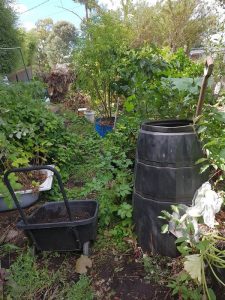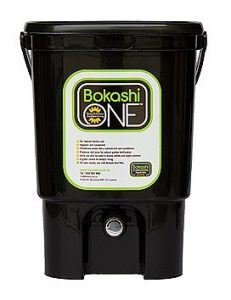Composting solutions for everyone
Lucinda Flynn, from Hurstbridge, is the owner of Going Green Solutions, a local company that sells eco-products.
It is common knowledge that organic waste going into landfill is literally such a waste of potential resources! Kept onsite in our homes and gardens, organic waste can be food for chickens, worms and micro-organisms, all of which help us grow more food for us.
When organic waste is thrown into landfill, we get nothing but methane (a potent greenhouse gas) so it’s worth doing everything possible to keep every scrap of organic waste on site. But what specifically is ‘organic waste’? What does it include? And what is the ‘best’ method of dealing with it?
What is ‘organic waste’ and what does it include?
Simply put, it is absolutely anything that is made from a material that was once living. The most obvious ones are kitchen scraps and garden waste; however, you can take this further and add all manner of materials – paper, cardboard, natural fibre clothing and materials, hair (after your haircut), cotton buds, and more. Just look at your waste material and think – has this been made out of a once living material such as a plant? If so, chances are that you can compost it.
What is the best method of dealing with it?
 There is no such method as ‘best’; rather, it is about what ‘best matches the situation’. Each home and each person will have different capacities to collect waste and may also have different preferred outcomes for their waste, so there is no ‘one-size-fits-all’ solution. The important thing is choosing a method or group of methods that work for you. This means choosing the method(s) that match what you want to compost, how much outdoor space you have, your living situation, and your lifestyle.
There is no such method as ‘best’; rather, it is about what ‘best matches the situation’. Each home and each person will have different capacities to collect waste and may also have different preferred outcomes for their waste, so there is no ‘one-size-fits-all’ solution. The important thing is choosing a method or group of methods that work for you. This means choosing the method(s) that match what you want to compost, how much outdoor space you have, your living situation, and your lifestyle.
8 possible methods are discussed below, namely:
- Compost bays: a good way of processing larger kinds of wastes, such as garden wastes, but they require both space and time.
- Chickens: “I can’t recommend chickens highly enough.“.
- Black compost bins with lids: good for kitchen food scraps.
- Bokashi bins: suitable for people with a smallish amount of kitchen scraps (e.g. a 2-person home) and can include meat, dairy, citrus and onion waste.
- Worm farms: a great option for smallish amounts of kitchen scraps, but not including meat, dairy, citrus or onion.
- Weed tea buckets: for noxious weeds that you need to keep out of compost.
- Council green waste bins: depends on your council.
- Give away your organic waste: e.g. via ShareWaste.com.
 1. Compost bays
1. Compost bays
Let’s talk about compost bays first, since this is a good way of processing larger kinds of wastes such as garden wastes. Compost bays will only be suitable if you have the space for them and (unless you are regular turning and watering them) are usually a longer term composting solution.
Compost bays are best suited for grass clippings, tree prunings, animal manure (horse, cow, pig, chicken, etc), natural fibre clothing & materials (including things such as old and falling apart featherdown quilts) and most of the weeds & spent plants from out of your veggie gardens.
 You can put kitchen scraps in a compost bay but my experience is that this is not such a great idea – our dog wanted to roll in it, rats and mice got perfect access, and it got smelly into the bargain.
You can put kitchen scraps in a compost bay but my experience is that this is not such a great idea – our dog wanted to roll in it, rats and mice got perfect access, and it got smelly into the bargain.
2. Chickens
If you have any space at all, I can’t recommend chickens highly enough. The key thing is to make sure you have a completely fox-free enclosure for them to live in, otherwise it can be heartbreaking.
If chickens are an option for you, they are an absolutely wonderful addition to any garden on a multitude of levels. Not only do they eat your kitchen scraps and turn them into eggs but, if you throw your garden waste (weeks and prunings from the veggie garden etc) in with them, they will turn it and gradually break it down into chook poo enriched compost that will help your veggies thrive.
 3. Black compost bins with lids
3. Black compost bins with lids
These are the most common kind of compost bin that you will see in the garden. Compost bins are good for kitchen food scraps and are based on the decomposition of organic waste by worms and microorganisms. If you have the space, I recommend having 3 of them – that way you can be filling one, while leaving two to the worms and the composting process.
For best results, and to keep them from smelling, cover it with some straw, sawdust or leaves each time you put in your kitchen waste. This dry, high-in-carbon material will balance the wet high-in-nitrogen kitchen scraps that you have added. Ideally, use a compost corkscrew to aerate the compost for time to time – it is anaerobic decomposition (where there is no air present) that results in the bad smell, so aerating it should keep it smelling fine. You might find it becomes absolutely filled with worms – they are composting your waste for you!
4. Bokashi bins
 Bokashi bins are suitable for people with a smallish amount of kitchen scraps (e.g. a 2-person home) and one of their benefits is that you can include meat, dairy, citrus and onion waste in the bin too (having said that, I include these things in the black compost bins too, but many people don’t like to). The bokashi bin can be stored in the kitchen cupboard, or a nearby space such as a laundry, and should only have to be emptied into the garden each month or so.
Bokashi bins are suitable for people with a smallish amount of kitchen scraps (e.g. a 2-person home) and one of their benefits is that you can include meat, dairy, citrus and onion waste in the bin too (having said that, I include these things in the black compost bins too, but many people don’t like to). The bokashi bin can be stored in the kitchen cupboard, or a nearby space such as a laundry, and should only have to be emptied into the garden each month or so.
Bokashi bins use a process of fermentation to break down organic waste, as opposed to decomposition (which is what happens in a regular compost bin). To use, collect your daily scraps in a container such as an ice-cream container with lid, then once a day, tip them into the bokashi bin, press down with your potato masher implement, sprinkle grain starter over it, and then replace the lid.
The bokashi powder that you sprinkle on a bokashi is not a chemical as such; rather, it is living microorganisms stored in an inactive form in a grain base. You can compare it to freeze dried yeast, which remains inactive until you mix it with warm water. Once the grain base is sprinkled into the bokashi bin and gets wet, the organisms come to life and start fermenting your food scraps. As long as you are using enough powder, your bokashi should never smell, which is why you can keep it indoors.
As the food ferments, liquid can be drained from the bin and diluted for using as a nutritious garden fertiliser. Once your bin is full, you can either tip the contents into your compost bin for further break down, or dig a hole in the garden and bury the contents in the hole. If you don’t have a garden, you could give the contents to a friend or neighbour who will love the addition of such rich organic matter into their own garden.
 5. Worm farms
5. Worm farms
A small sized worm farm is a great option for smallish amounts of kitchen scraps, but not including meat, dairy, citrus or onion because worms don’t like to eat those. You will need to be able to position your worm farm in a sheltered position so it does not over heat, and feed at a regular rate (if you over feed for the number of worms, the waste will start to rot).
You can make large scale worm forms too for large amounts of kitchen wastes – and the resulting worm castings are a fabulous addition to any garden.
6. Weed tea buckets
 All gardeners know that sometimes you have to pull up weeds that have the potential to spread even further if you add them to your compost – for example, blackberry, oxalis, kikuyu grass – so you need another solution if you want to keep all that lovely organic waste on site! Rather than throwing them in your green bin, weed tea buckets allow you to keep all their nutrients on hand while stopping them spreading.
All gardeners know that sometimes you have to pull up weeds that have the potential to spread even further if you add them to your compost – for example, blackberry, oxalis, kikuyu grass – so you need another solution if you want to keep all that lovely organic waste on site! Rather than throwing them in your green bin, weed tea buckets allow you to keep all their nutrients on hand while stopping them spreading.
Take a large bucket with a lid, fill it with weeds and water, and leave it with the lid on (to block out sunlight) for at least 10 weeks. You’ll come back to find a black sludge of composted weeds, along with the nutritious water they are sitting in that you can dilute and use as garden fertiliser on your garden.
7. Council green waste bins
Depending on where you live, most councils have a green waste bin that you can put garden scraps into, and this is an absolutely great idea of you don’t have the outdoor space, energy or time to compost your own garden waste. This waste is collected and commercially composted for other people to use – a win-win.
Some councils go further and allow this bin to also be used for kitchen organic wastes, which is also ideal for those without the capacity to compost them at home.
8. Give away your organic waste
If you have either kitchen scraps and/or garden scraps that you would really like to see composted but just don’t have the space or capacity yourself, you can sign up to a site such as ShareWaste.com, where you can register as either a ‘giver’ or a ‘receiver’ of scraps.
Alternatively, get in touch with your local community garden and see if they have a compost bin or pile for you to add to. Or perhaps a neighbour is keen to get their hands on your organic waste? There are always people out there who would love as much organic waste as they can get their hands on – it might seem like ‘waste’ to some people but, for others of us, it is a golden resource that we just can’t get enough of!
* * * * *
To summarise, treat your organic waste as the valuable resource that it is and, rather than allow it to be wasted in landfill, allow it to replenish your garden, your neighbour’s garden, and your community.
